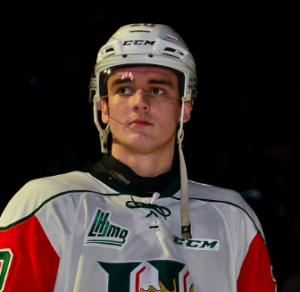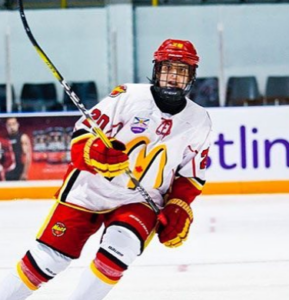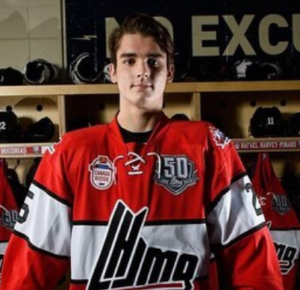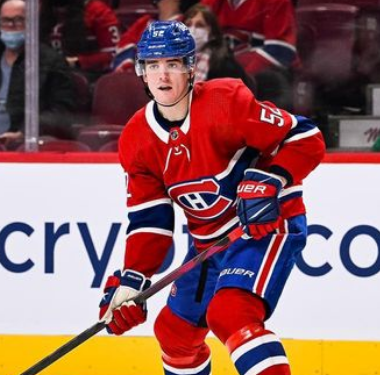Jacob Trouba’s hit on Justin Barron, and the ensuing fight with Mike Matheson, was a dramatic moment that highlighted the physical nature of hockey
While the hit itself was deemed legal, it left Barron bloodied and potentially concussed, raising concerns about player safety in the NHL.
Matheson’s defense of his teammate through a fight with Trouba showed the strong sense of camaraderie in hockey, but it also reignited the debate about whether fighting still has a place in the sport.
As both teams move forward, they will have to assess the impact of the incident on their respective rosters, with the Canadiens hoping for a quick recovery for Barron.
Meanwhile, the NHL continues to grapple with the balance between maintaining the sport’s physicality and protecting the safety of its players.
Michael Matheson’s journey to the NHL is a testament to his determination, skill, and willingness to make bold decisions in pursuit of his goals.
From his early years in Quebec to his time at Boston College and beyond, Matheson has consistently demonstrated a commitment to improving his game and leading by example. Now an alternate captain for the Montreal Canadiens, Matheson continues to make his mark as one of the league’s top defencemen.

Also Read: Jacob Trouba: Who Is He? Bio, wiki, Age, Career, Net Worth 2024 and More
Table of Contents
Jacob Trouba’s Hard Hit on Justin Barron
A Game-Changing Moment
In a tense third-period matchup between the New York Rangers and the Montreal Canadiens, a major physical incident occurred that left both teams shaken.1
The moment that set off a chain reaction involved Rangers defenseman Jacob Trouba and Canadiens defenseman Justin Barron.
Trouba delivered a powerful shoulder hit to Barron, causing an immediate stir on the ice and igniting a physical confrontation between players.
This key event not only affected the flow of the game but also raised questions about the nature of physicality in hockey and how such incidents should be handled moving forward.
Connecticut! Let’s work brodie @Davienk21 https://t.co/txZkRJzVwK
— Justin Barron🎱 (@justinbarron22) June 24, 2024
The Hit: Trouba’s Impact on Barron
The incident occurred during a fast-paced third period, with both teams pushing hard to gain an advantage. Jacob Trouba, known for his physical style of play, delivered a solid shoulder hit to Justin Barron, knocking him down hard to the ice.
The collision was forceful enough that Barron’s head hit the ice, and the Canadiens’ defenseman was left bloodied and dazed. Trainers quickly rushed to Barron’s side, helping him off the ice as he struggled with what appeared to be a nosebleed and likely a concussion from the impact.
Trouba’s hit on Barron was immediately scrutinized. Some hockey fans considered it a clean, hard hit—a reflection of the rough and tough nature of the sport—while others questioned whether it crossed the line into dangerous play.
Regardless of where fans fell on the issue, the aftermath of the hit left the Canadiens short one defenseman and concerned about Barron’s condition.

Mike Matheson’s Response
Hockey, as a sport, is built on camaraderie and protection of teammates, and this incident was no exception.2
Mike Matheson, another defenseman for the Canadiens, wasted no time rushing to Barron’s defense after the hit.
Matheson approached Jacob Trouba, signaling his intent to retaliate for what he viewed as a reckless play. The two players dropped their gloves, setting off a furious fight.
The fight between Matheson and Trouba was intense, with both players trading heavy punches. It was a show of strength and determination, as Matheson sought to stand up for his teammate, and Trouba defended his role in the hit.
In the world of hockey, where physical confrontation is not uncommon, fights like this are often seen as a way for players to express their frustrations and resolve disputes on the ice.
Penalties and Consequences
Once the dust settled, the referees had the challenging task of assessing penalties. Mike Matheson was given a penalty for instigating the fight, which included a fighting major and a 10-minute misconduct penalty.
The instigator penalty is designed to penalize players who are seen as starting fights, especially in response to plays they perceive as overly aggressive.
In contrast, Jacob Trouba was only assessed a fighting major, avoiding the harsher penalties that Matheson received.
While Trouba’s hit on Barron was a major catalyst for the confrontation, the officials deemed it a clean hit within the rules of the game. As a result, Trouba faced no additional discipline for the hit itself.
The Debate: Clean Hit or Dangerous Play?
The hit delivered by Trouba sparked a significant debate within the hockey community. Fans, analysts, and even players weighed in on whether the hit was clean or if it crossed the line into dangerous territory.
On one hand, some argued that Trouba was simply playing a hard-nosed style of hockey and that Barron’s unfortunate fall to the ice was a byproduct of a clean hit.
Others, however, saw the hit as an example of the dangers inherent in a physical game like hockey. They pointed out that Barron’s head hitting the ice could have resulted in a serious injury, and some questioned whether the league should take more steps to protect players in such situations.
In the NHL, hits like Trouba’s are often subject to review, and the league’s Department of Player Safety can choose to issue supplemental discipline if it deems the hit dangerous.
However, in this case, no further action was taken against Trouba, suggesting that the hit was within the bounds of what is considered acceptable by the league’s standards.Justin Barron: Fighting in Hockey
The fight between Matheson and Trouba also reignited discussions about the role of fighting in hockey.3
Unlike other professional sports, fighting is not only tolerated in hockey but is also sometimes seen as a way to police the game. Players often drop the gloves in response to perceived slights, dirty hits, or in defense of their teammates.
While some argue that fighting helps keep the game honest and prevents dirty play, others believe that it has no place in modern hockey, especially given the risks associated with concussions and other injuries.
The fight between Matheson and Trouba was an example of the former, as Matheson stood up for his teammate, believing Trouba’s hit to be excessive.

Player Safety: A Growing Concern
Justin Barron’s injury highlights the growing concern around player safety in the NHL. With increasing awareness of the long-term effects of concussions and head injuries, incidents like this are viewed through a more critical lens than in previous decades.
The league has taken steps to improve player safety, including stricter penalties for hits to the head and a more thorough concussion protocol.
However, hits like Trouba’s, which are not always deemed illegal by the rulebook, still pose a risk to players.
Barron’s head hitting the ice could have easily led to a more serious injury, and the incident serves as a reminder that even clean hits can have dangerous consequences. The league may need to continue evolving its approach to ensure player safety remains a priority.
Team Reactions and Moving Forward
- Both the New York Rangers and the Montreal Canadiens had strong reactions to the incident. For the Rangers, Trouba’s hit and the subsequent fight were seen as part of the team’s identity—tough, physical, and unafraid to stand their ground.
- Trouba himself is known for his physicality, and the Rangers often rely on him to set the tone in games.
- The Canadiens, on the other hand, were left dealing with the potential loss of a key defenseman.
- While Matheson’s defense of Barron was admirable, it didn’t change the fact that the team had to finish the game without Barron, which put them at a disadvantage.
- The Canadiens will now have to monitor Barron’s health closely and hope he can recover quickly.
- One of the larger issues raised by the incident is the importance of protecting key players on the ice. For both the Rangers and the Canadiens, players like Trouba and Barron are crucial to their teams’ success.
- The physical nature of hockey means that injuries are inevitable, but teams are constantly seeking ways to keep their best players healthy and on the ice.
- This incident serves as a reminder that even the hardest-working and most talented players are at risk when the game gets physical. Coaches, trainers, and medical staff must always be vigilant in ensuring that players are not put in harm’s way unnecessarily.

Also Read: Matthew Gaudreau’s Pro Hockey Career: Did He Get His NHL Shot?
Justin Barron: Bio
A Rising Star in Professional Ice Hockey
Justin Barron, born on November 15, 2001, is a talented Canadian professional ice hockey defenseman, currently playing for the Montreal Canadiens in the National Hockey League (NHL).
Known for his skill, vision, and leadership, Barron’s journey from junior hockey to the NHL showcases his dedication and potential.
This article delves into his career, from his early days in junior hockey to his rise in professional leagues, exploring the milestones that have defined his career so far.
Early Life and Introduction to Hockey
Hailing from Halifax, Nova Scotia, Justin Barron grew up in a region where hockey is deeply embedded in the local culture.
Like many young Canadians, Barron began playing hockey at a very young age, developing his skills and understanding of the game as he progressed through various youth leagues.
His early promise caught the attention of scouts and coaches, positioning him as a top prospect in his early teens.
His passion for hockey, combined with a strong work ethic, set him on a path toward a professional career.

Justin Barron: Career
Barron’s first significant step toward professional hockey came when he joined the Halifax Mooseheads of the Quebec Major Junior Hockey League (QMJHL) at the age of 16.
As a defenseman, Barron quickly stood out for his skating ability, puck-handling skills, and poise on the ice. Over three seasons with the Mooseheads, he developed into one of the team’s most reliable players, displaying maturity beyond his years.
During his time with the Mooseheads, Barron’s performance in the defensive zone and his ability to contribute offensively made him an attractive prospect for NHL scouts. He became known for his calm demeanor under pressure and his ability to control the game from the blue line.
By the end of his third season, Barron had established himself as one of the top defensive prospects in the 2020 NHL draft class.
Selection in the 2020 NHL Entry Draft
Justin Barron’s impressive junior career led to his selection in the 2020 NHL Entry Draft. The Colorado Avalanche, recognizing his potential, selected him in the first round, 25th overall.
This marked a significant milestone in Barron’s career, as being chosen in the first round of the NHL draft is a clear indication of a player’s skill and future potential. The Avalanche had high hopes for Barron, seeing him as a future cornerstone of their defensive corps.
View this post on Instagram
Captaincy and Leadership with the Mooseheads
Ahead of the 2020–21 season, Justin Barron was named captain of the Halifax Mooseheads, a testament to his leadership qualities both on and off the ice. Wearing the “C” for the Mooseheads, Barron embraced his role as a leader, guiding a young team through the challenges of a pandemic-interrupted season.
Despite the disruptions caused by COVID-19, Barron managed to play 33 games, recording an impressive 31 points, which included both goals and assists.
His leadership and consistent performance during this season further solidified his reputation as a top defensive prospect. Barron’s ability to balance his offensive contributions with his defensive responsibilities made him one of the most well-rounded players in the QMJHL.
His season as captain not only showcased his skills but also his ability to motivate and lead his teammates, qualities that would prove invaluable in his professional career.
Signing with the Colorado Avalanche
On April 27, 2021, the Colorado Avalanche signed Justin Barron to a three-year, entry-level contract, officially bringing him into the NHL fold.
This was a pivotal moment in Barron’s career, as he transitioned from junior hockey to the professional ranks. On the same day, he signed an amateur tryout (ATO) agreement with the Colorado Eagles, the Avalanche’s American Hockey League (AHL) affiliate.
This opportunity allowed Barron to gain professional experience while continuing to develop his game at a higher level of competition.
Barron’s time with the Colorado Eagles provided him with the chance to adjust to the speed and physicality of the professional game. Although his stay in the AHL was relatively brief, it served as an important stepping stone in his journey to the NHL.
Barron demonstrated his readiness for the next level, and his time with the Eagles helped him refine the aspects of his game that would make him successful in the NHL.
Also Read: Harmanpreet Singh, Vivek Sagar Prasad Headline Soorma Hockey Club Squad for HIL 2024-25




